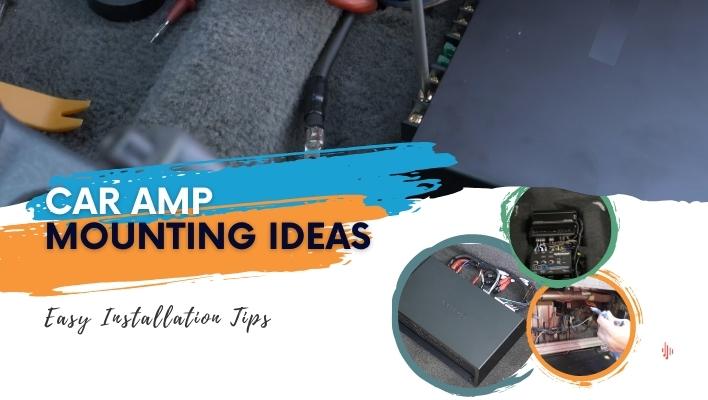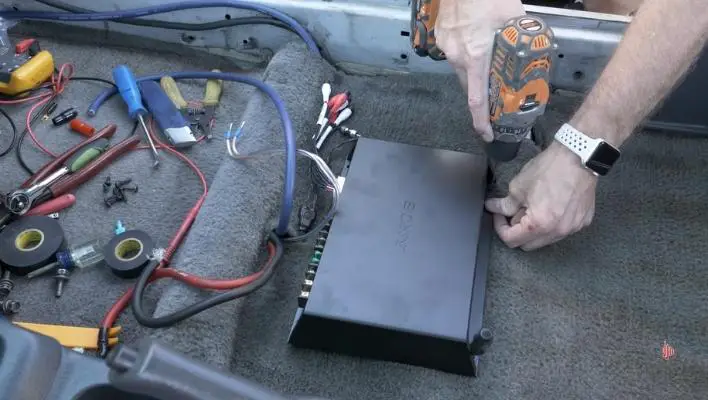Car amplifiers provide additional power to speakers in a car audio system, while allowing them to produce louder, clearer, and more detailed audio. Factory car stereos often have limited power output, which may not be sufficient for high-quality aftermarket speakers or for producing audio at higher volumes. An amplifier helps to bridge this gap by providing the necessary power needed to maximize the performance of your speakers.
Mounting a car amplifier involves working with electrical connections, which may require knowledge of basic electrical principles, including understanding polarity, grounding, and wiring techniques. If you are not familiar with these concepts, it may be challenging to properly install and connect the amplifier.
Luckily, many amplifiers have standard mounting options, such as using brackets or mounting screws, which can be easily installed with basic hand tools. In this article, we’ll explore some of the common car amplifier mounting ideas to make the work easier for you.

Car Amp Mounting Ideas
Mounting a car amplifier can be done in various ways depending on the specific vehicle, available space, and personal preferences. Here are some common car amplifier mounting ideas;
Trunk or cargo area
One of the most common places to mount a car amplifier is in the trunk or cargo area of the vehicle. Ideally, amplifiers can be securely mounted to the rear deck or sidewalls using brackets or screws. This can be a convenient location as it’s generally out of sight and provides easy access for wiring and connections.
To achieve this, you’ll need to look for a location in the trunk or cargo area that has enough space to accommodate the amplifier and any additional wiring or connections that may be needed. You may also want to ensure that the mounting surface is sturdy and can support the weight of the amplifier.
Additionally, ensure that the mounting surface is clean, dry, and free from any obstructions. If needed, you may need to remove any carpeting or trim to access a suitable mounting point. In addition, plan out the wiring and connections before mounting the amplifier. This includes routing the power and ground wires from the battery to the amplifier, as well as connecting the amplifier to your car’s audio system.
Under the seats
Another option is to mount the amplifier under one of the front seats if space allows. Some amplifiers are designed to be compact and low-profile, making them suitable for under-seat installations. This can help save space in the trunk or cargo area, especially in smaller vehicles or vehicles with limited trunk space.
In addition, this installation helps to keep the amplifier hidden from view, which helps minimize the risk of theft or damage. It also provides a convenient way to shorten the distance between the amplifier and the speakers, which helps to reduce the length of speaker wires.
However, installing the amplifier under the seats requires more careful planning and installation due to limited space and accessibility. It may also restrict the size and type of amplifier that can be installed and as such, it’s important to carefully measure and plan for clearance to ensure the amplifier fits properly and does not interfere with seat adjustments or other vehicle components.

Backseat car amp mounting ideas
Some vehicles have a foldable rear seat or a rear seat with removable cushions, which can provide ample space for mounting an amplifier. You can secure the amplifier using brackets or straps under the rear seat frame or the cushions.
If you have a larger vehicle, like an SUV or a van, you may consider mounting the amp on the backrest of the rear seats. This can help save trunk space while keeping the amp easily accessible for adjustments or maintenance.
However, make sure to choose a secure and stable mounting location that doesn’t interfere with the seat’s functionality or compromise passenger safety.
Behind the dashboard
In some vehicles, there may be enough space behind the dashboard to mount a small amplifier. Generally, installing the amplifier behind the dashboard can help save space in the trunk or other areas of the car where amplifiers are installed. This can be useful if you need to maximize storage or seating space in your vehicle.
It also helps to keep the interior of the car clean and free from visible wires or equipment, which may result in a more streamlined and aesthetically pleasing look. Equally important, it can help protect your amplifier from exposure to harsh weather conditions, temperature extremes, and potential damage from cargo or other items in the trunk.
Unfortunately, the space behind the dashboard may be limited and may not provide enough room for certain amplifier models, which could result in installation difficulties or compromises in the installation process.
In addition, placing the amplifier behind the dashboard can make it more difficult to access for maintenance, adjustments, or troubleshooting. If any issues arise or adjustments are needed, it may require removing dashboard components, which can be time-consuming and complicated.
Custom enclosure
If you have specific requirements for amplifier placement or want to create a custom installation, you can build a custom enclosure or mount the amplifier on a custom bracket. This allows for more flexibility in terms of placement and aesthetics but may require advanced DIY skills and tools.
Mounting a car amplifier using a custom enclosure can be a viable option for some installations, but it also comes with its own set of considerations and some drawbacks. For instance, building a custom enclosure for the amplifier allows for flexibility in terms of size, shape, and placement. This can be advantageous if you have specific requirements or constraints in your vehicle’s interior.
However, custom enclosures may require additional space in the vehicle for installation. As such, it’s important to consider the available space and make sure the custom enclosure does not interfere with other vehicle components, safety features, or the overall functionality of the vehicle.
Car audio amp rack ideas
Apart from a custom enclosure, you can also use amplifier racks to mount amplifiers in your car. Amplifier racks are specially designed mounting systems that provide a secure and organized way to install amplifiers in any vehicle.
Amplifier racks consist of a metal or plastic frame or rack that securely holds the amplifier and can be attached to a specific location in the vehicle, such as the trunk, under a seat, or in the cargo area. The best thing about amplifier racks is that they are available in various sizes and configurations, making them adaptable to different amplifier models, vehicle types, and installation locations.
Using an amplifier rack can help streamline the installation process, as it provides a predefined mounting solution that eliminates the need for custom fabrication or modifications to your vehicle or trunk’s interior.
However, amplifier racks can take up valuable space in your vehicle, especially if you have limited interior space or a small vehicle. Depending on the size of your amplifier and the design of the rack, it may require a significant amount of space, which can impact the functionality and aesthetics of your vehicle.
In addition, some amplifier racks may require modification to your vehicle’s interior, such as drilling holes or removing interior panels, which may not be reversible. This can potentially impact the resale value of your vehicle or void warranties on certain parts or components.
Tips for Mounting a Car Amplifier
Accessibility
Choose a location that allows easy access to the amp for adjustments, maintenance, and troubleshooting. Avoid mounting it in hard-to-reach or obstructed areas that may make it difficult to reach the amp when needed.
Ventilation
Amplifiers generate heat during operation, so it’s important to mount them in a location that provides adequate ventilation to dissipate heat. Avoid enclosed spaces or areas that may restrict airflow, as overheating can cause performance issues or even damage to the amp. Also, leave some clearance around the amplifier to allow for airflow, and consider using a cooling fan or heat sink if needed.
Security considerations
Ensure that the amp is securely mounted to prevent it from coming loose or shifting during vehicle movement. Vibrations and shocks from driving can potentially damage the amp or cause it to produce unwanted noise.
Wiring
Consider the ease of running wiring from the amp to the audio source, speakers, and power source
. A location that allows for clean and concealed wiring can help maintain the aesthetics and functionality of your audio system.
Once the amplifier is mounted, double-check all the connections to ensure they are properly secured. This includes power and ground connections, as well as speaker connections. Make sure all wires are properly routed and protected to prevent any potential damage or interference.
Space
Take into account the available space in your vehicle, considering factors such as the size of the amp, the type of vehicle (sedan, hatchback, SUV, etc.), and your specific audio system setup. Different vehicles may have different optimal locations for amp mounting due to variations in space and layout.
Safety
Avoid mounting the amp in a location that may interfere with the safe operation of the vehicle or pose a safety risk to passengers in case of an accident or sudden stop.
Test and troubleshoot
After installation, test the amplifier to ensure its functioning properly. If you encounter any issues, troubleshoot and address them promptly to ensure optimal performance.
Conclusion
Generally, there is no single ‘best’ place to mount a car amplifier as it can vary depending on factors such as the vehicle’s layout, your audio system setup, and personal preferences. As such, it’s important to carefully evaluate these factors and choose a location that best meets your specific requirements and preferences. If you’re unsure about the best location or lack the necessary expertise, it’s recommended to seek professional assistance from a qualified car audio installer to ensure a safe installation.
